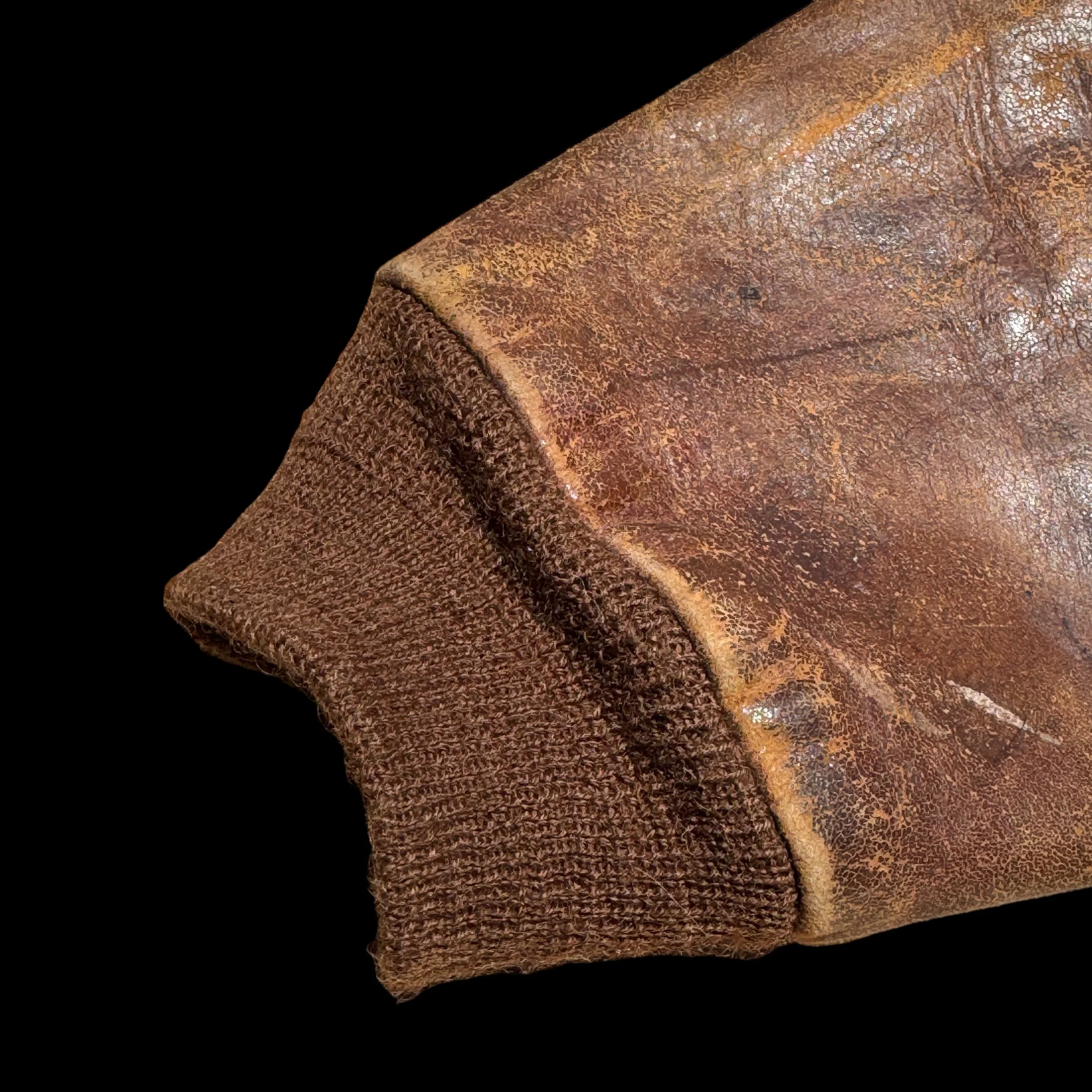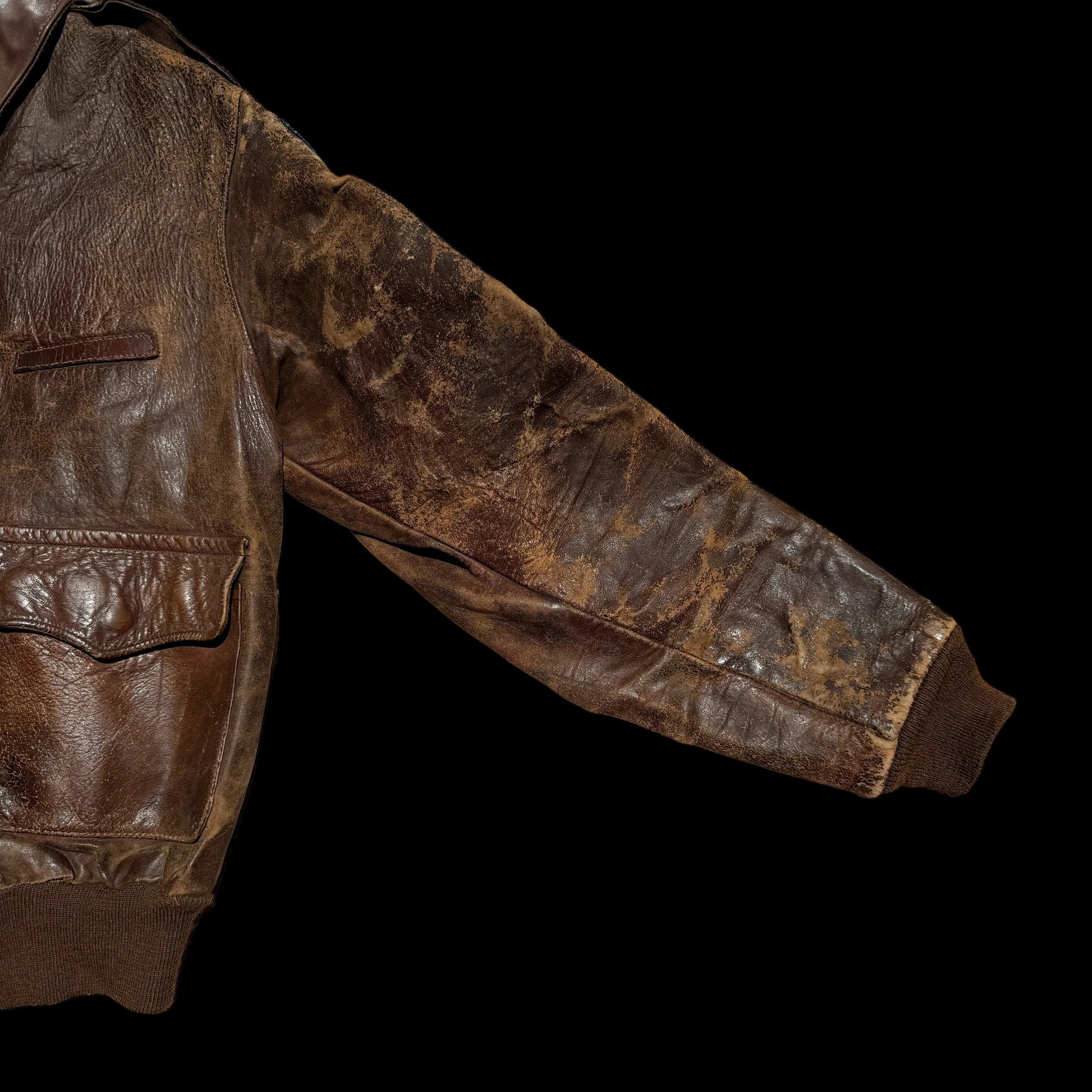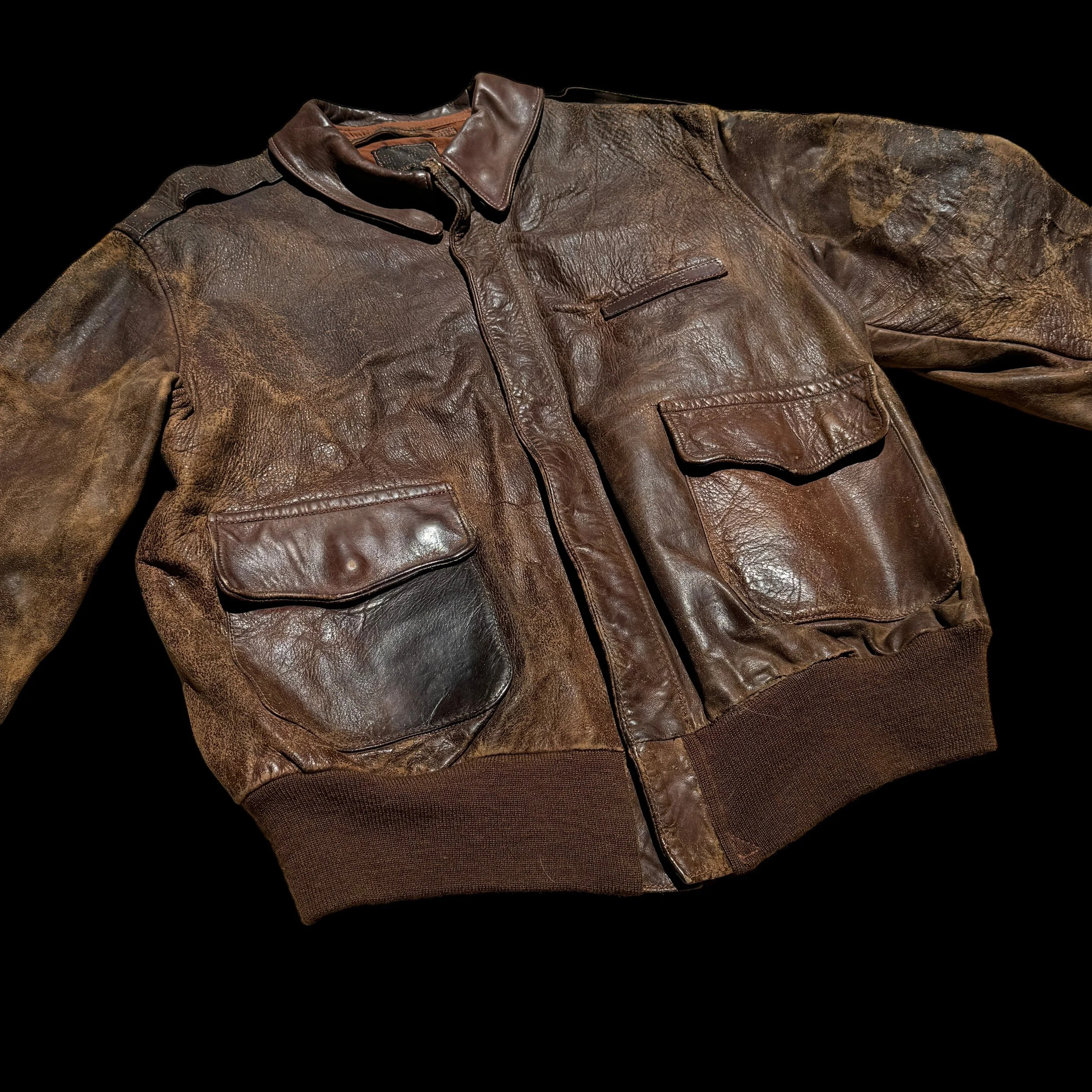VERY RARE! WWII U.S. Air Force First Lieutenant H. Lee "Heavily Combat-Worn" European Theater Pilot Leather Combat Mission Flight Jacket





























VERY RARE! WWII U.S. Air Force First Lieutenant H. Lee "Heavily Combat-Worn" European Theater Pilot Leather Combat Mission Flight Jacket
Comes with a hand-signed C.O.A.
This incredibly rare and museum-grade WWII artifact is a heavily combat-worn European Theater pilot jacket worn by First Lieutenant H. Lee while serving in the U.S. Air Force. These pilot flight jacket were almost always worn by pilots during their length of their entire combat service, mearning this jacket was worn by 1st Lt. H. Lee on all of his combat mission against Nazi German forces across the European Theater.
The leather flight jacket, particularly the Type A-2, stands as a symbol of courage and camaraderie among pilots during World War II. Its significance extends beyond its practical use, embodying the spirit and resilience of the airmen who fought in the European Theater.
Historical Context and Development
The Type A-2 leather flight jacket was officially adopted by the U.S. Army Air Corps in 1931, succeeding the Type A-1 jacket. Designed for both functionality and style, the A-2 featured high-quality horsehide leather, a snap-down collar, knit cuffs and waistband, and a front zipper closure. It was intended to provide warmth and protection in the open cockpits of early aircraft while allowing freedom of movement.
As the war progressed, materials shifted from horsehide to goatskin and cowhide due to supply constraints. Despite these changes, the A-2 maintained its distinctive look and practical features, becoming a staple of the U.S. Army Air Forces.
Use by Pilots in the European Theater
Fighter Pilots
Fighter pilots, such as those flying the P-47 Thunderbolt and P-51 Mustang, found the A-2 jacket indispensable. These aircraft, designed for speed and agility, often engaged in dogfights at high altitudes where temperatures dropped significantly. The A-2's tight knit cuffs and waistband helped retain body heat, while its leather construction provided some protection against the wind.
Fighter pilots personalized their jackets with squadron patches, nose art, and kill counts, transforming each A-2 into a unique piece of wartime memorabilia. This customization fostered a sense of identity and pride, boosting morale among the pilots.
Bomber Crews
Bomber crews, operating aircraft like the B-17 Flying Fortress and B-24 Liberator, faced different challenges. Their missions often involved long hours at high altitudes under freezing conditions. While the A-2 jacket was initially part of their standard gear, it became less practical for the extreme cold experienced on these flights.
To address this, bomber crews layered their A-2 jackets over electrically heated flight suits or replaced them with B-3 shearling jackets, which provided superior insulation. Nevertheless, the A-2 remained a symbol of their service and was often worn off-duty or during ground operations.
Transport and Reconnaissance Pilots
Pilots flying transport and reconnaissance missions, such as those in the C-47 Skytrain or F-5 Lightning, also relied on the A-2 jacket. These roles required less combat engagement but involved extensive flying hours under varying weather conditions. The A-2's durability and comfort made it suitable for the diverse tasks these pilots undertook, from supply drops to photographic reconnaissance.
Cultural Impact and Legacy
The A-2 jacket transcended its military use to become an enduring symbol of the WWII aviator. Hollywood films and post-war media romanticized the image of the brave, leather-clad pilot, cementing the A-2's place in popular culture. Notable figures, such as General Douglas MacArthur and Charles Lindbergh, also contributed to its iconic status by frequently wearing the jacket.
After the war, surplus A-2 jackets were sold to civilians, further integrating the jacket into American fashion. Its rugged design and association with heroism made it a sought-after item, influencing future generations of military and civilian outerwear.
The Type A-2 leather flight jacket, worn by pilots across various aircraft during WWII, symbolizes the bravery and camaraderie of those who served in the European Theater. From fighter aces to bomber crews, the A-2 provided essential protection and a canvas for personal expression. Its legacy endures, reminding us of the sacrifices made by the Greatest Generation and the timeless allure of the leather flight jacket.
The US Air Force in the European Theater During WWII: Missions and Operations
The United States Army Air Forces (USAAF) played a pivotal role in the Allied victory during World War II, particularly in the European Theater of Operations (ETO). The USAAF’s strategic bombing campaigns, tactical support for ground forces, and innovative use of air power transformed the nature of warfare and contributed significantly to the defeat of Nazi Germany.
Formation and Evolution of the USAAF
Before delving into specific missions and operations, it is essential to understand the context in which the USAAF was formed and evolved during WWII. The USAAF was established on June 20, 1941, evolving from the United States Army Air Corps. The need for a more autonomous and robust air force became evident as global tensions rose, and the United States prepared for potential involvement in the war. Under the leadership of General Henry H. Arnold, the USAAF expanded rapidly, growing from a modest force to one of the most formidable air powers in the world.
Strategic Bombing Campaign
The strategic bombing campaign was a cornerstone of the USAAF’s efforts in the ETO. The primary objective was to cripple Germany’s industrial capacity, undermine its war economy, and break the morale of the German population. This campaign was executed through a series of operations that targeted key industrial centers, transportation hubs, and military installations.
Operation Pointblank
One of the most significant operations was Operation Pointblank, initiated in June 1943. This directive aimed to achieve air superiority over Europe by targeting the German aircraft industry and its associated infrastructure. The USAAF’s Eighth Air Force, based in England, played a crucial role in these missions. Flying long-range bombers such as the B-17 Flying Fortress and the B-24 Liberator, the Eighth Air Force undertook daylight precision bombing raids.
The success of Operation Pointblank was instrumental in weakening the Luftwaffe, Germany's air force. By targeting aircraft production facilities, the USAAF significantly reduced the number of operational German fighters, which was a critical factor in gaining air superiority in preparation for the D-Day invasion.
The Combined Bomber Offensive
The Combined Bomber Offensive (CBO), a joint effort between the USAAF and the Royal Air Force (RAF), sought to destroy Germany’s war-making capacity through round-the-clock bombing. The RAF conducted nighttime raids while the USAAF focused on daytime precision bombing. Notable targets included the industrial Ruhr Valley, oil refineries, and transportation networks.
The bombing of the ball-bearing plants in Schweinfurt and the aircraft factories in Regensburg in August 1943 exemplified the high-risk, high-reward nature of these missions. Despite heavy losses, the destruction of these facilities disrupted German war production and highlighted the strategic importance of the USAAF’s efforts.
Tactical Air Support
In addition to strategic bombing, the USAAF provided crucial tactical air support to ground forces. This involved close air support (CAS) missions, interdiction of enemy supply lines, and air superiority missions to protect ground operations.
Operation Cobra
One of the most notable instances of tactical air support was during Operation Cobra, launched in July 1944. This operation aimed to break through the German defenses in Normandy following the D-Day landings. The USAAF, along with other Allied air forces, conducted concentrated bombing raids on German positions, creating a breakthrough that allowed ground forces to advance rapidly.
The success of Operation Cobra demonstrated the effectiveness of integrating air power with ground operations. The ability to disrupt enemy communications, supply lines, and reinforcements through air strikes significantly enhanced the mobility and effectiveness of Allied ground forces.
The Battle of the Bulge
During the Battle of the Bulge in December 1944, the USAAF played a critical role in repelling the German counteroffensive. Despite adverse weather conditions initially grounding many aircraft, the USAAF provided essential air support once the skies cleared. P-47 Thunderbolts and P-51 Mustangs, among other aircraft, conducted ground-attack missions that targeted German armored columns, supply lines, and troop concentrations. The air support was pivotal in halting the German advance and turning the tide in favor of the Allies.
Key Operations and Their Impact
Several key operations and missions illustrate the breadth and impact of the USAAF’s efforts in the ETO. These operations not only showcased the strategic and tactical capabilities of the USAAF but also underscored the critical importance of air power in modern warfare.
Operation Overlord (D-Day)
The success of Operation Overlord, the Allied invasion of Normandy on June 6, 1944, was heavily dependent on air superiority and the preparatory bombing campaigns conducted by the USAAF. Leading up to D-Day, the USAAF, in coordination with the RAF, carried out extensive bombing raids on German coastal defenses, transportation networks, and communication centers. On D-Day itself, USAAF fighters provided air cover for the invasion forces, while bombers targeted enemy fortifications and supply lines.
The Oil Campaign
Recognizing the importance of fuel for the German war machine, the USAAF focused significant efforts on the Oil Campaign. Targeting oil refineries, synthetic fuel plants, and storage facilities, this campaign aimed to cripple Germany’s ability to sustain its military operations. The bombing of the Ploiești oil fields in Romania in August 1943, though costly in terms of aircraft and crew losses, exemplified the strategic importance of denying the enemy access to vital resources.
Strategic Bombing of Dresden
In February 1945, the USAAF participated in the controversial bombing of Dresden. Alongside the RAF, the USAAF conducted extensive bombing raids on the city, resulting in widespread destruction and significant civilian casualties. While the strategic justification was to disrupt German communications and logistics, the moral and ethical implications of this raid have been debated extensively. The bombing of Dresden remains one of the most contentious episodes of the USAAF’s campaign in the ETO.
Technological and Tactical Innovations
The USAAF’s success in the ETO was not solely due to the bravery and skill of its aircrews but also to technological and tactical innovations. Advancements in aircraft design, navigation, and bombing accuracy played a crucial role.
Development of Long-Range Bombers
The development and deployment of long-range bombers such as the B-17 Flying Fortress and the B-24 Liberator were pivotal. These aircraft allowed the USAAF to conduct deep penetration raids into German territory, striking targets that were previously out of reach. The introduction of the B-29 Superfortress, though more prominently used in the Pacific Theater, also represented a significant leap in strategic bombing capability.
Use of Fighter Escorts
The integration of long-range fighter escorts, particularly the P-51 Mustang, significantly improved the effectiveness of bombing missions. The P-51’s extended range allowed it to accompany bombers deep into enemy territory, providing crucial protection against German fighters. This development was instrumental in reducing bomber losses and ensuring the success of strategic bombing raids.
Advancements in Bombing Accuracy
Technological innovations such as the Norden bombsight improved bombing accuracy, allowing for more precise targeting of industrial and military installations. The use of radar for navigation and bombing also enhanced the effectiveness of nighttime and all-weather operations.
The contributions of the USAAF in the European Theater of Operations during WWII were multifaceted and indispensable to the Allied victory. Through strategic bombing campaigns, tactical air support, and innovative use of air power, the USAAF played a critical role in weakening Nazi Germany’s war-making capacity, supporting ground operations, and ultimately securing air superiority. The legacy of the USAAF’s efforts in the ETO is a testament to the transformative power of air warfare and the enduring importance of air power in modern military strategy.